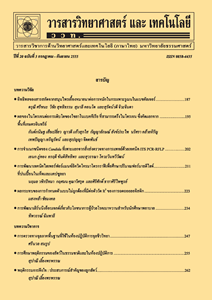การเปรียบเทียบประสิทธิภาพของตัวสถิติทดสอบสำหรับการทดสอบความแตกต่างของค่ากลางระหว่างประชากร 2 กลุ่ม ที่อิสระกัน
Main Article Content
Abstract
บทคัดย่อ
วัตถุประสงค์ของการศึกษาครั้งนี้ คือ เพื่อเปรียบเทียบประสิทธิภาพของตัวสถิติทดสอบทั้งหมด 6 วิธี ได้แก่ ตัวสถิติทดสอบ Z ตัวสถิติทดสอบสติวเดนต์ที ตัวสถิติทดสอบเวลช์ที ตัวสถิติทดสอบแมนน์-วิตนีย์ ตัวสถิติทดสอบโดยมัธยฐาน และตัวสถิติทดสอบแวนเดอวอลเด็น รวมถึงเพื่อเสนอแนะตัวสถิติทดสอบที่เหมาะสม จำแนกสถานการณ์โดยกำหนดประชากรที่มีทั้งการแจกแจงปรกติ การแจกแจงเบ้ซ้ายที่มีความโด่งสูงกว่าปรกติ การแจกแจงเบ้ซ้ายที่มีความโด่งต่ำกว่าปรกติ การแจกแจงเบ้ขวาที่มีความโด่งสูงกว่าปรกติ และการแจกแจงเบ้ขวาที่มีความโด่งต่ำกว่าปรกติ กำหนดอัตราส่วนค่าเฉลี่ยประชากรกลุ่มที่ 1 และกลุ่มที่ 2 ทั้งหมด 3 ระดับ คือ 1, 0.9 และ 1.2 อัตราส่วนความแปรปรวนประชากรกลุ่มที่ 1 และกลุ่มที่ 2 ทั้งหมด 3 ระดับ คือ 1, 0.25 และ 4 ขนาดตัวอย่างจากประชากร 2 กลุ่ม 9 ขนาด คือ (10, 10), (30, 30), (100, 100), (15, 10), (45, 30), (150, 100), (10, 15), (30, 45) และ (100, 150) ระดับนัยสำคัญที่ศึกษา คือ 0.01 และ 0.05 จำลองข้อมูลด้วยการเขียนโปรแกรม SAS กำหนดจำนวนรอบของการทำซ้ำ คือ 1,000 รอบ ผลการศึกษาพบว่าตัวสถิติทดสอบ Z สามารถควบคุมความน่าจะเป็นที่จะเกิดความผิดพลาดแบบที่ 1 ได้ตามเกณฑ์ที่กำหนดและมีกำลังการทดสอบสูงกว่าตัวสถิติทดสอบอื่นๆ แต่ตัวสถิติทดสอบนี้จำเป็นต้องทราบค่าความแปรปรวนประชากรทั้ง 2 กลุ่ม ดังนั้นจึงควรใช้ตัวสถิติทดสอบที่มีความเหมาะสมรองลงมา คือ ตัวสถิติทดสอบสติวเดนต์ทีหรือเวลช์ที โดยกรณีความแปรปรวนประชากรทั้ง 2 กลุ่ม มีค่าเท่ากัน ตัวสถิติทดสอบสติวเดนต์ทีจะมีความเหมาะสมมากกว่าเวลช์ที แต่กรณีความแปรปรวนประชากรทั้ง 2 กลุ่ม มีค่าไม่เท่ากัน ตัวสถิติทดสอบเวลช์ทีจะมีความเหมาะสมมากกว่า สำหรับตัวสถิติทดสอบไม่อิงพารามิเตอร์ที่ศึกษา มีความเหมาะสมในบางกรณีแต่ยังไม่มีแนวโน้มที่ชัดเจนมากนัก เช่น โดยส่วนใหญ่ตัวสถิติทดสอบแมนน์-วิตนีย์ ตัวสถิติทดสอบโดยมัธยฐาน และตัวสถิติทดสอบแวนเดอวอลเด็นมีความเหมาะสมกับตัวอย่างขนาดเล็กถึงขนาดกลาง และตัวสถิติทดสอบโดยมัธยฐานมีความเหมาะสมกับการทดสอบสมมุติฐานที่กำหนดระดับนัยสำคัญ 0.01 มากกว่าที่ระดับนัยสำคัญ 0.05 กรณีตัวอย่างทั้ง 2 กลุ่ม มีขนาดใหญ่และความแปรปรวนประชากรมีค่าเท่ากัน จะสามารถใช้ตัวสถิติทดสอบใดก็ได้ เนื่องจากมีประสิทธิภาพไม่แตกต่างกัน
คำสำคัญ : การทดสอบความแตกต่างของค่ากลาง; ความน่าจะเป็นที่จะเกิดความผิดพลาดแบบที่ 1; กำลังการทดสอบ
Abstract
The objective of this study was to compare the performance of six test statistics: Z, Student’s t, Welch’s t, Mann-Whitney, Median, and Van der Waerden. Including the recommending the appropriate test statistic. Classification of the population according to normal distribution, left-skewed and leptokurtic kurtosis distribution, left-skewed and platykurtic kurtosis distribution, right-skewed and leptokurtic kurtosis distribution, and right-skewed and platykurtic kurtosis distribution. The ratios of mean group 1 per group 2 were 1, 0.9, and 1.2. The ratios of variance group 1 per group 2 were 1, 0.25, and 4. The sample sizes of two populations were nine sizes: (10, 10), (30, 30), (100, 100), (15, 10), (45, 30), (150, 100), (10, 15), (30, 45), and (100, 150). The significance levels that to study were 0.01 and 0.05. The data were simulated by using SAS programming with 1,000 replicates. Results of the research were Z test statistic could control the probability of type I error and had higher power of a test than other test statistics, but this test is necessary to know the variances of the two groups. Therefore, it was appropriate to apply the other test statistics, i.e., Student’s t or Welch’s t. If the variances of the two groups were equal, Student’s t was a more appropriate test statistic than Welch’s t. But, if the variances of the two groups were not equal, Welch’s t was a more appropriate. Nonparametric test statistics for this study were appropriate in some cases but no clear, i.e., Mann-Whitney, Median, and Van der Waerden were appropriate for small to medium sample sizes. The median was appropriate to test the hypothesis that given the significance level of 0.01 over the 0.05 level of significance. When both sample sizes were large and the population variances were equal, we could use any tests since there is no difference in the performance.
Keywords: central difference test; probability of type I error; power of a test

